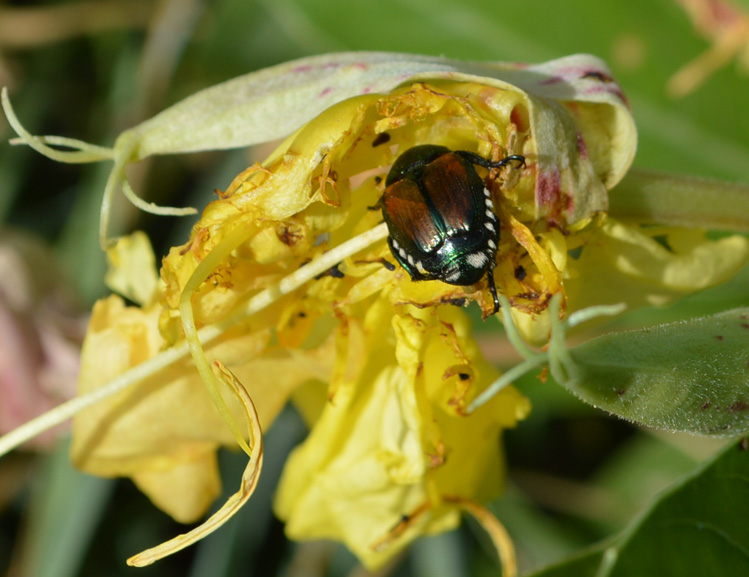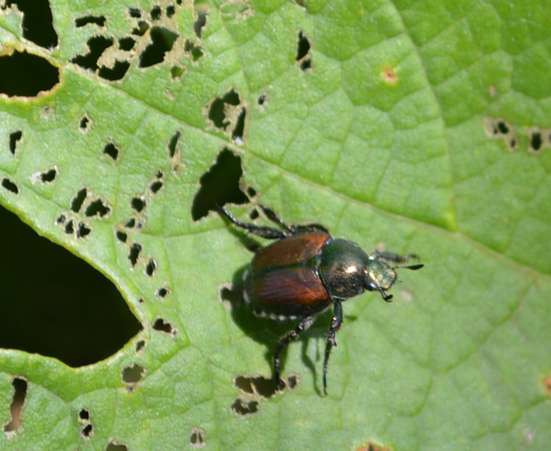
Japanese beetle eating an Oenothera flower at the Denver Botanic Gardens.
Gardeners around Colorado’s Front Range are coming face to face with a new foe in our landscapes. Japanese beetles have been a pest for years in U.S. gardens in the east, south and mid-west. It is only relatively recently that the feared invasive pest has made its presence known in Colorado.
The beetles (Popillia japonica) are believed to have entered North America via New Jersey in 1916, probably hitchhiking on ornamental nursery stock from Asia. They are voracious feeders, doing damage to trees, shrubs, perennials, annuals and turf grass. Some of the 300 favorite food plants of the adult Japanese beetles are roses, Virginia creeper, grape vines, raspberries, linden, elm and fruit trees. The sign of their destruction is skeletonized foliage and flower petals that have been devoured. The adult beetles feed during the day, preferring hot and sunny days.

Japanese beetle on a “skeletonized” grape leaf at the Denver Botanic Gardens.
The beetle’s one-year life cycle seems tailor made for a traditional lush turf and shrub landscape. They spend winter underground as a grub, feeding on turf grass roots, creating dead patches in the lawn. In June they begin to emerge as adults ready to feed on the flowers and leaves of plants. The adults can be found feeding on plants as late as September. In addition to feeding on your landscape plants, they might be seen mating on those plants. After mating, females will move to turf grass lawns to dig into the soil to deposit their eggs. After depositing eggs, the females will resume feeding on host plants. The females will return to the lawn to lay more eggs. Up to 60 eggs can be laid by each female beetle during her 4-8 week life span.
Back in the turf grass soil, the eggs will hatch and the Japanese beetle larvae will emerge and move to the grass roots to feed. The larvae are most susceptible to drying out and dying when young if the soil dries out. That is one reason some experts advise against over watering lawns in mid to late summer. The larvae will develop rapidly, causing much damage to the turf grass roots, eventually killing some of the turf grass plants. The larvae feed on the grass roots until the temperature drops below 60 degree F. The larvae move deeper down into the soil to overwinter. Once the soil warms up in spring, the larvae move back up through the soil to resume feeding on the grass roots for about 4 to 6 weeks. After that, they begin to pupate. A couple weeks after pupation, the adults will emerge from the soil to feed on leaves and flowers, mate and start the cycle all over.
The worst damage caused by the Japanese beetles seems to be to lawns, where the larvae can cause dead patches. It appears the damage to shrubs and trees is mostly cosmetic, and will not kill those plants. However, this cosmetic damage can be significant and will upset most gardeners.
Unfortunately there is no magic bullet to control Japanese beetles in your landscape. If you discover them when they first arrive, using manual methods to collect them is a wise choice. Do not crush them, or the chemicals released upon squishing will attract more Japanese beetles to your yard. Try collecting them in a jar of soapy water. Traps are not recommended because they also attract more beetles to your yard. Pesticides may be effective at controlling the beetles. However some systemic pesticides have been linked to death of beneficial pollinating insects such as bees. For more information on the safe use of pesticides and other methods to control Japanese beetles, visit the Colorado State Extension webpage on the subject. Some experts advise the application of grub killing pesticides to lawns to kill the Japanese beetle larvae and keep your turf from being destroyed. The extension does say this about trying to control the larvae of Japanese beetles: “Some cultural practices can limit damage and applied chemical or biological controls may also be useful. However, control of Japanese beetle larvae in a yard will have very little, if any, effect on the number of Japanese beetle adults feeding on trees, shrubs and garden plants. The insect is highly mobile so that problems with adult beetles typically involve insects that have moved a considerable distance.”
As mentioned earlier, dry turf soil during the egg laying season (mostly in June & July) will keep some larvae from surviving to become adults. Some experts recommend drying out your lawn and letting it go dormant during the typical Japanese beetle egg laying time, and resuming watering after the eggs have been layed. This would seem a challenging approach to the problem as most people prefer a green, non-dormant lawn during the time of year when a lush lawn is much desired. The extension service does recommend that keeping lawns well watered after egg laying (and once the older larvae are present and most actively feeding) may help the turf survive root injuries caused by larval feeding.
It would appear that typical xeriscape plants are not usually favored by the beetles. This is yet another reason that a xeric and regionally appropriate landscape design is a good approach to follow in Denver and Colorado in general.
Let’s hope we can keep this exotic and invasive pest at bay, and not let it become an established nuisance.
This is the official blog of Outdoor Design Group, Colorado Landscape Architects. For more information about our business and our services, click here.